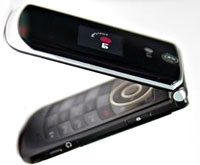 LG has unveiled the KG810 clamshell phone; a super slim, quad band GSM handset which will be sold in Asia, China, Europe and CIS markets.
LG has unveiled the KG810 clamshell phone; a super slim, quad band GSM handset which will be sold in Asia, China, Europe and CIS markets.
Although we’re not generally fans of the clamshell phones (our attempts to casually flip the things open one-handedly invariably saw the phone flying off into the distance), but the KG810 is certainly a bit of a looker.
Like the slider KG800 chocolate phone, the KG810 features the same external “Infrared Sensor” buttons on the front for controlling music playback.
These work by heat detection, so there should be little chance of you activating the controls when the phones in your pocket – unless you’re in the habit of carrying hot coals around in your pants, of course.
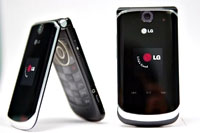 Under the screen there’s a touch-sensitive keypad and a fairly healthy 128 MB of internal memory.
Under the screen there’s a touch-sensitive keypad and a fairly healthy 128 MB of internal memory.
Naturally, the phone comes with all the usual multimedia widgets we expect to see on ‘lifestyle’ gadgets, with a 1.3 megapixel camera with video recording, bluetooth, FM radio, voice memo and music player bringing up the feature set.
It’s a pipsqueak of a phone too, measuring a handbag-unbulging 14.6mm thick. Pricing and availability is not known yet.
There’s been wide confusion over this, so let’s clear it up for you. The KG810 isn’t part of the Black label, design-driven phone line. The KG800, the ‘Chocolate phone’ is – and is currently the only phone in the Black label range. Thank to LG for getting in touch about this and clearing it up.
Barrel scraping celeb-fest
LG have been keen to insist that their ‘Black labal’ range of phones will lead punters into a world of impossible glamour and sophistication, with a recent glitzy London launch seeing freebie phones dished out to schlebs like Pierce Brosnan, Gwyneth Paltrow and Claudia Shiffer (our invitation must have got lost in the post).
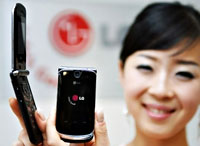 Although these stars were clearly happy to scoop up any expensive freebies coming their way, when it came to electing the UK’s “primary Chocolate phone ambassador,” LG found the celebrity cupboard somewhat bare.
Although these stars were clearly happy to scoop up any expensive freebies coming their way, when it came to electing the UK’s “primary Chocolate phone ambassador,” LG found the celebrity cupboard somewhat bare.
Finally settling on a barrel-scraping Z list ‘celebrity’ – whom we suspect wasn’t their first choice – LG awarded Colleen McLoughlan the ambassador’s job, enthusiastically insisting that she is a ‘fashion icon.’ LG _insist_ that Colleen was their choice numero uno, seeing her and her recent transformation to a ‘girl of style’ as perfect for the phone.
Just in case you’re not in tune with the world of ‘fashion icons’ we can inform you that Ms McLoughlan is in fact the girlfriend of nobbled England footie star, Wayne Rooney.
We can see that impressed you.
“The LG Chocolate phone is working as an accessory for any outfit. It’s unique, sleek and exactly the right size to pop into any handbag for any occasion. The black and red theme really makes this phone stand out and the touch sensitive buttons make it beautiful,” she enthused to anyone who would listen.
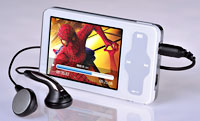 After consulting the well thumbed iPod design book, Chinese electronics manufacturers Meizu have rolled out their new Meizu Mini, a truly Lilliputian Personal Media Player.
After consulting the well thumbed iPod design book, Chinese electronics manufacturers Meizu have rolled out their new Meizu Mini, a truly Lilliputian Personal Media Player.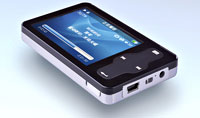 Other onboard gizmos include Synchronized Lyric Display, E-book, alarm clock, calculator, calendar and some (unspecified) games.
Other onboard gizmos include Synchronized Lyric Display, E-book, alarm clock, calculator, calendar and some (unspecified) games.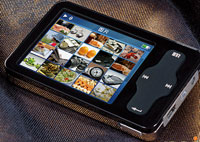 So far we’ve only seen Chinese language screen shots but the interface seems crisp and slick enough to us.
So far we’ve only seen Chinese language screen shots but the interface seems crisp and slick enough to us.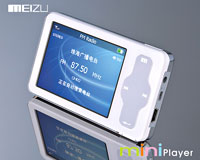 The player comes with a white or black finish and a metal back just like the – yep, you’ve guessed it – iPod.
The player comes with a white or black finish and a metal back just like the – yep, you’ve guessed it – iPod.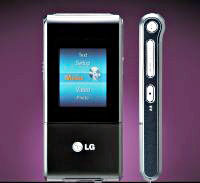 It may not have the swish designer lines of the iPod and the name may roll off the tongue as smoothly as a mouth full of dry nuts, but LG Electronics new MFJM53 MP3 player looks more than a bit useful.
It may not have the swish designer lines of the iPod and the name may roll off the tongue as smoothly as a mouth full of dry nuts, but LG Electronics new MFJM53 MP3 player looks more than a bit useful.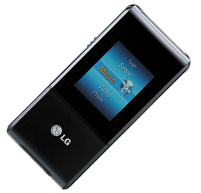 Although we like the look of this fella – the feature set particularly impresses – the lack of a scroll/clickwheel is going to seriously hamper its ability to challenge the dominance of the uber-iPod.
Although we like the look of this fella – the feature set particularly impresses – the lack of a scroll/clickwheel is going to seriously hamper its ability to challenge the dominance of the uber-iPod. At the W3C conference in Edinburgh today, in a move to get the mobile industry (and possibly more) to standardise on a single Web browser, Nokia has released the source code for the mobile Web browser it developed last year.
At the W3C conference in Edinburgh today, in a move to get the mobile industry (and possibly more) to standardise on a single Web browser, Nokia has released the source code for the mobile Web browser it developed last year. “We want to reduce the fragmentation currently in place in mobile browsing,” said Lee Epting, VP of Forum Nokia, Nokia’s software development support program.
“We want to reduce the fragmentation currently in place in mobile browsing,” said Lee Epting, VP of Forum Nokia, Nokia’s software development support program.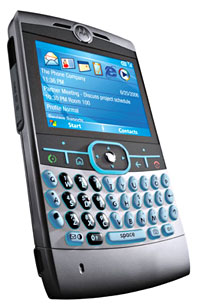 Months later than expected, Motorola’s new ‘Blackberry-killer’ smartphone, the Moto Q has finally been launched on the Verizon network in the US.
Months later than expected, Motorola’s new ‘Blackberry-killer’ smartphone, the Moto Q has finally been launched on the Verizon network in the US.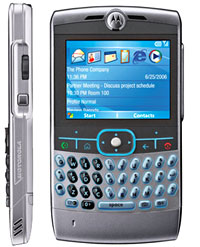 Shockley insisted that the Q is for people with a “life balance” (a what?) who want to use their phones to listen to music, take photos, record short videos and play games.
Shockley insisted that the Q is for people with a “life balance” (a what?) who want to use their phones to listen to music, take photos, record short videos and play games.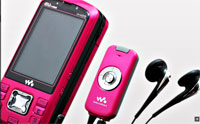 Sony Ericsson has announced its first Walkman phone for Japan today and it looks like a beaut.
Sony Ericsson has announced its first Walkman phone for Japan today and it looks like a beaut.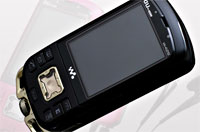 True to its Walkman heritage, the slide-out phone has a smorgasbord of built-in dedicated music controls, including a natty new mechanical navigation wotsit bolted on to the bottom of the phone.
True to its Walkman heritage, the slide-out phone has a smorgasbord of built-in dedicated music controls, including a natty new mechanical navigation wotsit bolted on to the bottom of the phone.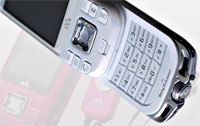 There’s been no firm announcement of the retail price yet, although it’s hotly rumoured to be around the $180 mark, and no announcement of a UK release yet, natch.
There’s been no firm announcement of the retail price yet, although it’s hotly rumoured to be around the $180 mark, and no announcement of a UK release yet, natch. Nordic mobile goliaths Nokia have unveiled an upgrade for their Nokia 770 Internet Tablet which gives the chunky device VoIP and instant messaging capabilities through Google Talk.
Nordic mobile goliaths Nokia have unveiled an upgrade for their Nokia 770 Internet Tablet which gives the chunky device VoIP and instant messaging capabilities through Google Talk.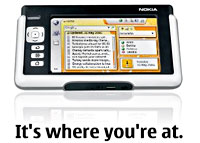 Sales weren’t too hot though, but Nokia reckon that by bolting on VoIP phone capabilities they can turbo charge unit-shifting, with Virtanen insisting that internet telephony is “the key for us to reach higher sales volumes.”
Sales weren’t too hot though, but Nokia reckon that by bolting on VoIP phone capabilities they can turbo charge unit-shifting, with Virtanen insisting that internet telephony is “the key for us to reach higher sales volumes.”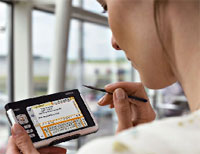 The updated OS also boasts enhanced text typing with full-screen finger keyboard, improved memory performance and a ‘refreshed’ look (did they throw a bucket of water at it, or something?).
The updated OS also boasts enhanced text typing with full-screen finger keyboard, improved memory performance and a ‘refreshed’ look (did they throw a bucket of water at it, or something?). Palm have announced the successor to their hugely successful Palm OS-powered Treo 650 smartphone, the Treo 700p.
Palm have announced the successor to their hugely successful Palm OS-powered Treo 650 smartphone, the Treo 700p. Bundled with the phone is DataViz’ Documents To Go for reading and editing Microsoft Office files, a PDF viewer and an email client that works with Exchange Server 2003 via ActiveSync, plus POP and IMAP accounts.
Bundled with the phone is DataViz’ Documents To Go for reading and editing Microsoft Office files, a PDF viewer and an email client that works with Exchange Server 2003 via ActiveSync, plus POP and IMAP accounts.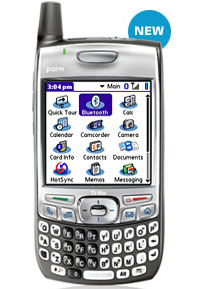 So much so that we’re even prepared to forgive the omission of Wi-Fi in the latest Treo (Palm in the US insist that EV-DO should be enough.)
So much so that we’re even prepared to forgive the omission of Wi-Fi in the latest Treo (Palm in the US insist that EV-DO should be enough.)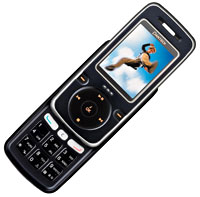 Straight out of the school of Advanced Homage to iPods comes this new music phone from South Korean phone maker Pantech.
Straight out of the school of Advanced Homage to iPods comes this new music phone from South Korean phone maker Pantech.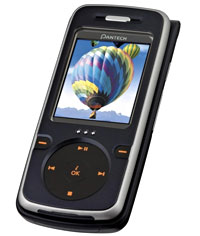 Rounding off the phone’s feature set is stereo audio-enabled Bluetooth and a speakerphone in the 10.2 x 4.7 x 1.8cm package which weighs in at 94.1g.
Rounding off the phone’s feature set is stereo audio-enabled Bluetooth and a speakerphone in the 10.2 x 4.7 x 1.8cm package which weighs in at 94.1g.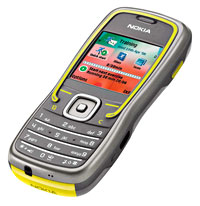 For hyperactive sporty types, lardy lumps looking to lose some weight and headband-totin’ workouters, Nokia has trotted out its new super-sporty phone, the 5500 Sport.
For hyperactive sporty types, lardy lumps looking to lose some weight and headband-totin’ workouters, Nokia has trotted out its new super-sporty phone, the 5500 Sport.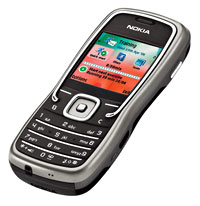 Jog the line
Jog the line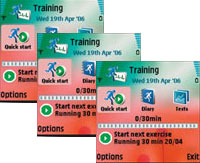 Music on the go
Music on the go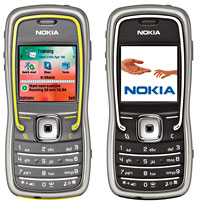 Conveniently, there’s a dedicated key that makes it easy to switch between phone, music and training modes with text to speech software feeding you text messages and workout status reports on the move.
Conveniently, there’s a dedicated key that makes it easy to switch between phone, music and training modes with text to speech software feeding you text messages and workout status reports on the move.